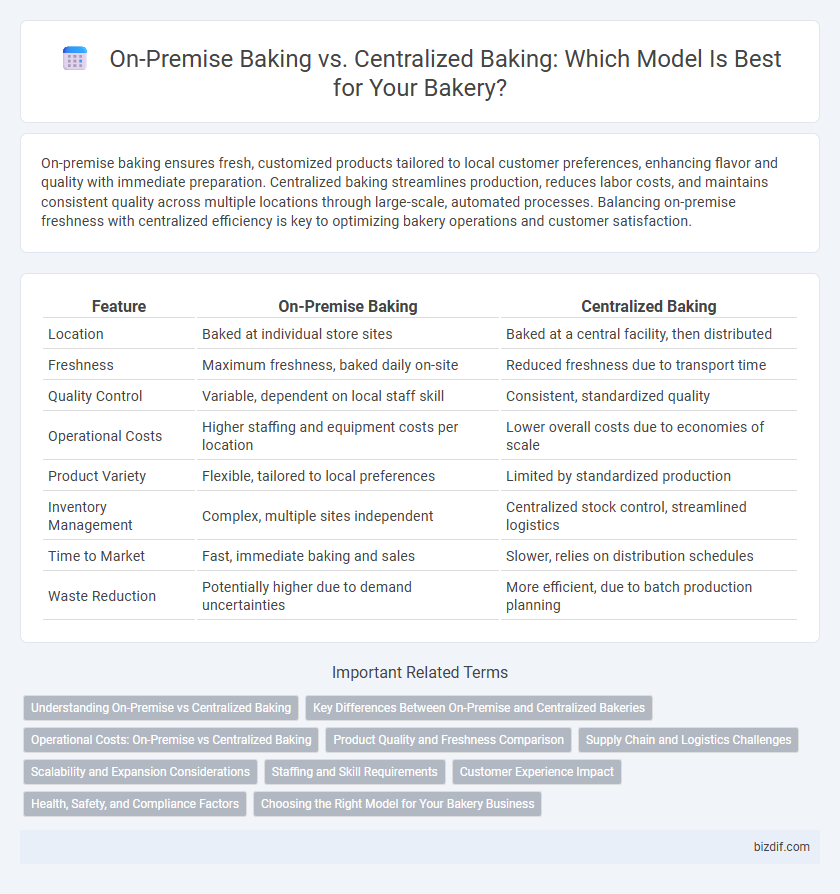On-premise baking ensures fresh, customized products tailored to local customer preferences, enhancing flavor and quality with immediate preparation. Centralized baking streamlines production, reduces labor costs, and maintains consistent quality across multiple locations through large-scale, automated processes. Balancing on-premise freshness with centralized efficiency is key to optimizing bakery operations and customer satisfaction.
Table of Comparison
| Feature | On-Premise Baking | Centralized Baking |
|---|---|---|
| Location | Baked at individual store sites | Baked at a central facility, then distributed |
| Freshness | Maximum freshness, baked daily on-site | Reduced freshness due to transport time |
| Quality Control | Variable, dependent on local staff skill | Consistent, standardized quality |
| Operational Costs | Higher staffing and equipment costs per location | Lower overall costs due to economies of scale |
| Product Variety | Flexible, tailored to local preferences | Limited by standardized production |
| Inventory Management | Complex, multiple sites independent | Centralized stock control, streamlined logistics |
| Time to Market | Fast, immediate baking and sales | Slower, relies on distribution schedules |
| Waste Reduction | Potentially higher due to demand uncertainties | More efficient, due to batch production planning |
Understanding On-Premise vs Centralized Baking
On-premise baking involves producing baked goods directly within individual store locations, ensuring freshness and allowing customization to meet local customer preferences, which enhances the overall customer experience. Centralized baking consolidates production in a single facility, optimizing operational efficiency, consistency, and cost control through economies of scale, but may compromise the perceived freshness of products. Choosing between on-premise and centralized baking depends on balancing quality, logistics, and brand strategy to align with business goals and consumer expectations.
Key Differences Between On-Premise and Centralized Bakeries
On-premise bakeries produce fresh baked goods directly at the sales location, ensuring customized recipes and immediate product availability for customers. Centralized bakeries operate from a single, large facility that produces baked items at scale and distributes them to various retail outlets, optimizing cost efficiency and consistency. Key differences include production scale, freshness levels, customization ability, and distribution logistics.
Operational Costs: On-Premise vs Centralized Baking
On-premise baking incurs higher operational costs due to the necessity for localized equipment, labor, and raw material storage at each store location, increasing overhead expenses. Centralized baking reduces these costs by consolidating production into a single location, benefiting from economies of scale, streamlined inventory management, and reduced labor requirements. Transportation and distribution costs may rise with centralized baking but are often offset by overall lower production expenses and improved quality control.
Product Quality and Freshness Comparison
On-premise baking ensures superior product quality and freshness by delivering baked goods directly to customers shortly after production, preserving texture and flavor. Centralized baking offers consistency and uniformity through controlled processes but may experience diminished freshness due to transportation and storage times. Optimizing logistics and timing is crucial in centralized baking to maintain quality comparable to on-premise bakeries.
Supply Chain and Logistics Challenges
On-premise baking requires extensive coordination of raw material deliveries and inventory management at multiple locations, increasing complexity in supply chain logistics. Centralized baking consolidates production, reducing transportation costs and simplifying inventory control but demands efficient distribution networks to maintain product freshness. Balancing these logistics challenges directly impacts operational efficiency and customer satisfaction in bakery supply chains.
Scalability and Expansion Considerations
On-premise baking allows bakeries to maintain control over product freshness and customization but faces limitations in scalability due to space and resource constraints. Centralized baking facilities provide significant advantages for expansion, enabling consistent quality and streamlined production that supports multiple retail locations efficiently. Choosing centralized baking can facilitate rapid growth and cost savings by leveraging economies of scale and reducing duplication of equipment across stores.
Staffing and Skill Requirements
On-premise baking demands skilled bakers capable of managing diverse tasks such as dough preparation, baking, and quality control directly at the retail location, often requiring a larger, versatile staff. Centralized baking benefits from specialized teams focused on high-volume production with standardized processes, reducing the need for multifaceted skills and allowing for leaner staffing. Efficiency in staffing and skill specialization can significantly affect operational costs and product consistency in both baking models.
Customer Experience Impact
On-premise baking enhances customer experience by offering freshly baked goods with appealing aromas and immediate availability, which strengthens brand trust and satisfaction. Centralized baking enables consistent product quality and cost efficiency, but may lead to longer delivery times and reduced freshness perception among customers. Balancing freshness and operational efficiency is crucial for bakeries aiming to optimize customer satisfaction and loyalty.
Health, Safety, and Compliance Factors
On-premise baking allows for greater control over ingredient quality and adherence to specific health and safety regulations within individual locations, reducing contamination risks. Centralized baking facilities benefit from standardized compliance protocols and rigorous food safety audits, ensuring consistent product quality across multiple outlets. Both models require strict adherence to HACCP guidelines and local health codes to maintain optimal safety and regulatory compliance.
Choosing the Right Model for Your Bakery Business
On-premise baking offers superior freshness and customization by producing goods directly in the bakery, ideal for businesses prioritizing artisan quality and immediate customer service. Centralized baking enhances operational efficiency and consistency by consolidating production in a single facility, reducing costs and simplifying inventory management for bakeries with multiple locations. Evaluating factors such as product variety, scale, delivery logistics, and customer expectations helps determine the optimal balance between freshness and efficiency for your bakery business.
On-premise baking vs Centralized baking Infographic

 bizdif.com
bizdif.com